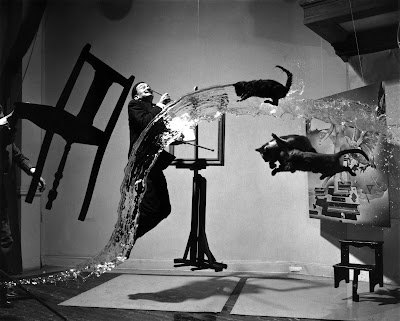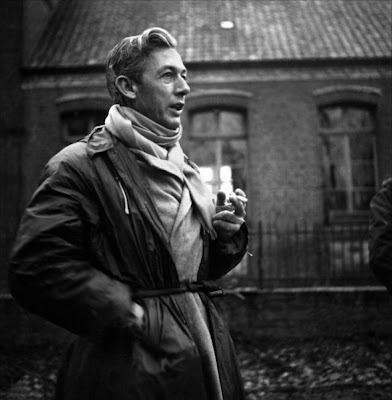Contemplate Art Gallery
&
Konangal
&
Konangal
jointly present
DOCUMENTARIES ON ART
 SALVADOR DALI
SALVADOR DALI20th Nov 2010 ; 5.45 pm
Contemplate Art Gallery
2nd floor , Rajshree Ford Bldg.
Opp- PSG Krishnammal College
Avanashi Road
1. Documentary on Salvador Dali
2. " Private Life of a Masterpiece"
documentary on Dali’s great masterpiece
“Christ of Saint John of the Cross"
 Salvador Dali is considered as the greatest artist of the surrealist art movement and one of the greatest masters of art of the twentieth century. During his lifetime the public got a picture of an bizarre paranoid. His personality caused a lot of controversy.
Salvador Dali is considered as the greatest artist of the surrealist art movement and one of the greatest masters of art of the twentieth century. During his lifetime the public got a picture of an bizarre paranoid. His personality caused a lot of controversy. Salvador Dali was born as the son of a prestigious notary in the small town of Figueras in Northern Spain. His talent as an artist showed at an early age and Salvador Felipe Jacinto Dali received his first drawing lessons when he was ten years old. Dali began to study art at the Royal Academy of Art in Madrid. In 1928 Dali went to Paris where he met the Spanish painters Pablo Picasso and Joan Miro. He established himself as the principal figure of a group of surrealist artists grouped around Andre Breton,. He also partnered with the great surrealist film maker Luis Bunuel in the making of two films.
Salvador Dali was born as the son of a prestigious notary in the small town of Figueras in Northern Spain. His talent as an artist showed at an early age and Salvador Felipe Jacinto Dali received his first drawing lessons when he was ten years old. Dali began to study art at the Royal Academy of Art in Madrid. In 1928 Dali went to Paris where he met the Spanish painters Pablo Picasso and Joan Miro. He established himself as the principal figure of a group of surrealist artists grouped around Andre Breton,. He also partnered with the great surrealist film maker Luis Bunuel in the making of two films. By 1929 Dali had found his personal style that should make him famous - the world of the unconscious that is recalled during our dreams. The surrealist theory is based on the theories of the psychologist Dr. Sigmund Freud. Recurring images of burning giraffes and melting watches became the artist's surrealist trademarks. His great craftsmanship allowed him to execute his paintings in a nearly photo-realistic style. No wonder that the artist was a great admirer of the Italian Renaissance painter Raphael.
By 1929 Dali had found his personal style that should make him famous - the world of the unconscious that is recalled during our dreams. The surrealist theory is based on the theories of the psychologist Dr. Sigmund Freud. Recurring images of burning giraffes and melting watches became the artist's surrealist trademarks. His great craftsmanship allowed him to execute his paintings in a nearly photo-realistic style. No wonder that the artist was a great admirer of the Italian Renaissance painter Raphael. Meeting Gala was the most important event in the artist's life and decisive for his future career. For him she was everything. Most of all Gala was a stabilizing factor in his life. And she managed his exhibitions in Europe and United States.
Meeting Gala was the most important event in the artist's life and decisive for his future career. For him she was everything. Most of all Gala was a stabilizing factor in his life. And she managed his exhibitions in Europe and United States.  To evade World War II, Dali chose the U.S.A. as his permanent residence in 1940. He had a series of spectacular exhibitions, among others a great retrospective at the Museum of Modern Art in New York. His art works became a popular trademark and besides painting he pursued other activities - jewelry and clothing designs for Coco Chanel or film making with Alfred Hitchcock.
To evade World War II, Dali chose the U.S.A. as his permanent residence in 1940. He had a series of spectacular exhibitions, among others a great retrospective at the Museum of Modern Art in New York. His art works became a popular trademark and besides painting he pursued other activities - jewelry and clothing designs for Coco Chanel or film making with Alfred Hitchcock. In 1948 Dali and Gala returned to Europe. Dali developed a lively interest in science, religion and history. He integrated things into his art that he had picked up from popular science magazines. Another source of inspiration were the great classical masters of painting like Raphael, Velasquez or the French painter Ingres. In 1958 the artist began his series of large sized history paintings. Dali is the only known artist who had two museums dedicated exclusively to his works at lifetime.
In 1948 Dali and Gala returned to Europe. Dali developed a lively interest in science, religion and history. He integrated things into his art that he had picked up from popular science magazines. Another source of inspiration were the great classical masters of painting like Raphael, Velasquez or the French painter Ingres. In 1958 the artist began his series of large sized history paintings. Dali is the only known artist who had two museums dedicated exclusively to his works at lifetime.  Towards the end of his life, Dali lived in the tower of his own museum where he died on January 23, 1989 from heart failure.
Towards the end of his life, Dali lived in the tower of his own museum where he died on January 23, 1989 from heart failure.










